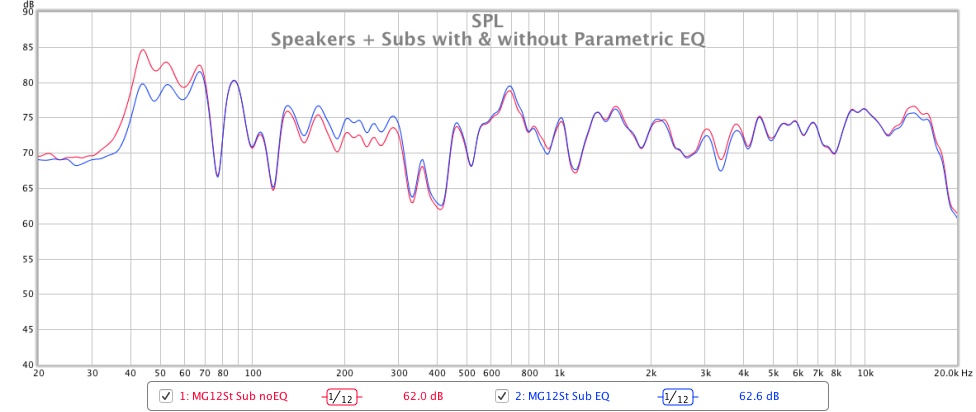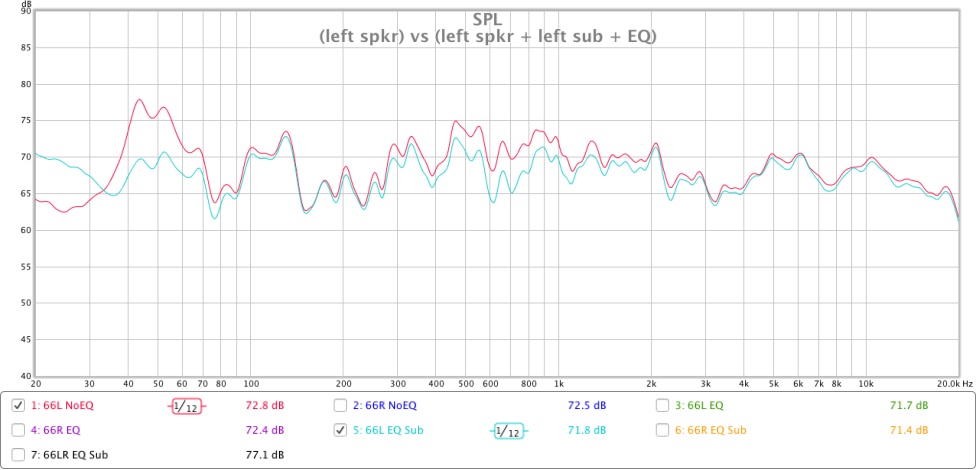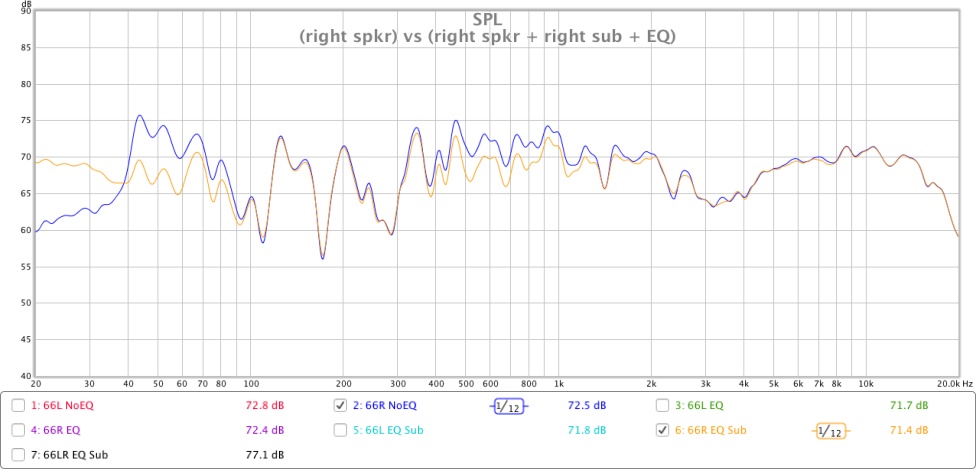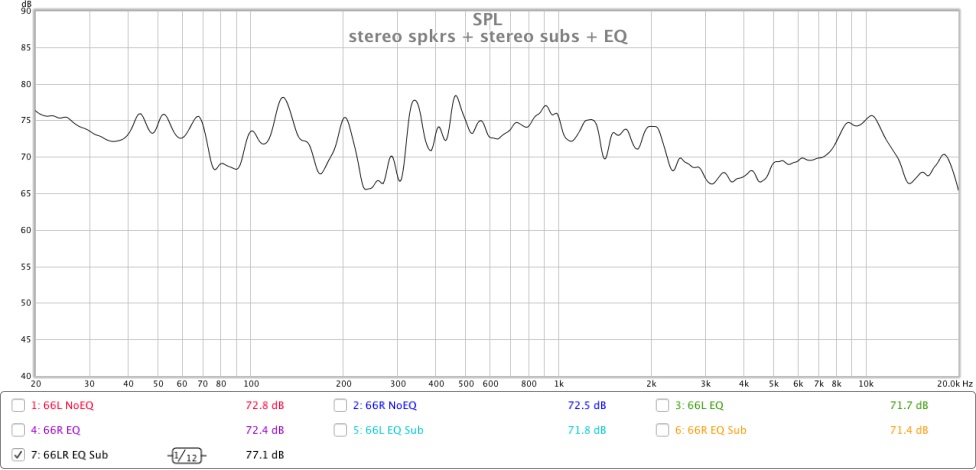You are using an out of date browser. It may not display this or other websites correctly.
You should upgrade or use an alternative browser.
You should upgrade or use an alternative browser.
Yamaha NS1000M
- Thread starter cooky1257
- Start date
torstoi
pfm Member
Yes, well this was suggested by the guy who kindly lend me his dsp and operated the measurements.
I have to admit it was nothing I would have come up with myself & took a bit until I got my head wrapped around it, so..
You are right, the potis of the mid and tweeter do of course, not affect the bass as such..
But if you add 3 dB to the mids and also to the tweeter
and you then correct the volume on your pre back to the previous level (by about 3dB)
then in consequence the bass will be 3 dB less in relation to before.
By +3 dB for mid and tweeter, both will have + 3 dB in relation to the bass at any volume,
or, in other words:
the bass will be 3 dB reduced in relation to mid/tweeter at any volume.
So what you are actually hearing when you make mid & tweeter more prominent
and listen with the same volume you usually do,
is effectively by ~3 dB less bass.
I have to admit it was nothing I would have come up with myself & took a bit until I got my head wrapped around it, so..
You are right, the potis of the mid and tweeter do of course, not affect the bass as such..
But if you add 3 dB to the mids and also to the tweeter
and you then correct the volume on your pre back to the previous level (by about 3dB)
then in consequence the bass will be 3 dB less in relation to before.
By +3 dB for mid and tweeter, both will have + 3 dB in relation to the bass at any volume,
or, in other words:
the bass will be 3 dB reduced in relation to mid/tweeter at any volume.
So what you are actually hearing when you make mid & tweeter more prominent
and listen with the same volume you usually do,
is effectively by ~3 dB less bass.
ToTo Man
the band not the dog
Yes, well this was suggested by the guy who kindly lend me his dsp and operated the measurements.
I have to admit it was nothing I would have come up with myself & took a bit until I got my head wrapped around it, so..
You are right, the potis of the mid and tweeter do of course, not affect the bass as such..
But if you add 3 dB to the mids and also to the tweeter
and you then correct the volume on your pre back to the previous level (by about 3dB)
then in consequence the bass will be 3 dB less in relation to before.
By +3 dB for mid and tweeter, both will have + 3 dB in relation to the bass at any volume,
or, in other words:
the bass will be 3 dB reduced in relation to mid/tweeter at any volume.
So what you are actually hearing when you make mid & tweeter more prominent
and listen with the same volume you usually do,
is effectively by ~3 dB less bass.
OK I thought this might be the explanation. It may work very well for reducing the 40Hz mode, but unless you also suffer from the rest of your bass frequencies being too loud, then you are also effectively reducing the level of your overall bass output, which might make the NS1000M sound leaner than neutral.
e.g. in my room, all my loudspeakers have a room mode at 43Hz, but they also suffer from weaker bass between 100Hz and 400Hz due to floor/ceiling cancelations, therefore I must be careful only to reduce output below 100Hz, otherwise the sound will become too lean and lack warmth.

torstoi
pfm Member
You are right, of course..
It depends on a many things, not the least how excellent or not your power amp is capable of controlling
the paper membrane of the bass.
Then the human ear is not a microphone and a laptop combined, so we tend to always get distracted by the loudest event
present at the moment, any too prominent bass mode would start preventing a good view onto the midrange.
On the other hand, the 40Hz range -spoken for the music I mostly listen- is much less busy then the midrange,
so it's also probably good advice to take measures in a healthy (careful) dose..
The room mode at ~40 Hz is not a catastrophe, but quite common, and also probably our brain does a bit of compensation for that already.
To me the mid speaker in the NS1000 is it's best part by far...and thus I try to get as much from that as I can.
The rest around it is implemented very very well, and so to me overall performance is just great.
Most of the relevant information to me is comming from the midband, and thus my emphasis is also there.
In other words, I would rather make compromise somewhere in the bass than in the midrange,
and would rather reduce it a tiny bit than accepting it's tendency to shade over the midband.
But there's no general rule to this of course...room circumstances, personal musical taste, the ability of an amp to have or have not
absolute control over the bass embrane...may make the suggested 15% reduction either pleasant or a bit of a dubious measure.
That's why I suggested to try it out for a while...say one week...then turn it back to neutral
& decide for yourself which kind of presentation you prefer.
Whatever you perceive sounding better is perfectly fine..
Those frequency graphics are nice to see if you have major issues anywhere, and also if a chassis may have an issue,
but I think it's important not to get crazy over a few visable gaps or peaks here & there
as long as the performance you are hearing is great.
I've seen more or less perfectly linear graphs of speakers that sounded absolutely *not-so-good*
but they were far from performing anywhere near the NS.
What I did was to catch a view at my one major issue, the 40Hz mode, did a tiny bit of improvement about it..
and am basicly fine now..
It depends on a many things, not the least how excellent or not your power amp is capable of controlling
the paper membrane of the bass.
Then the human ear is not a microphone and a laptop combined, so we tend to always get distracted by the loudest event
present at the moment, any too prominent bass mode would start preventing a good view onto the midrange.
On the other hand, the 40Hz range -spoken for the music I mostly listen- is much less busy then the midrange,
so it's also probably good advice to take measures in a healthy (careful) dose..
The room mode at ~40 Hz is not a catastrophe, but quite common, and also probably our brain does a bit of compensation for that already.
To me the mid speaker in the NS1000 is it's best part by far...and thus I try to get as much from that as I can.
The rest around it is implemented very very well, and so to me overall performance is just great.
Most of the relevant information to me is comming from the midband, and thus my emphasis is also there.
In other words, I would rather make compromise somewhere in the bass than in the midrange,
and would rather reduce it a tiny bit than accepting it's tendency to shade over the midband.
But there's no general rule to this of course...room circumstances, personal musical taste, the ability of an amp to have or have not
absolute control over the bass embrane...may make the suggested 15% reduction either pleasant or a bit of a dubious measure.
That's why I suggested to try it out for a while...say one week...then turn it back to neutral
& decide for yourself which kind of presentation you prefer.
Whatever you perceive sounding better is perfectly fine..
Those frequency graphics are nice to see if you have major issues anywhere, and also if a chassis may have an issue,
but I think it's important not to get crazy over a few visable gaps or peaks here & there
as long as the performance you are hearing is great.
I've seen more or less perfectly linear graphs of speakers that sounded absolutely *not-so-good*
but they were far from performing anywhere near the NS.
What I did was to catch a view at my one major issue, the 40Hz mode, did a tiny bit of improvement about it..
and am basicly fine now..
torstoi
pfm Member
...and where do you place this in case of the NS1000 & a 40 Hz mode, for example..?
edit: I just googled about it a bit & found out it's a wooden closed box with some holes in it to tune it to a certain frequency.
The volume is 200 to 1000 liter,,and while it sounds interesting,
that's too much space I don't have spare in my livingroom
edit: I just googled about it a bit & found out it's a wooden closed box with some holes in it to tune it to a certain frequency.
The volume is 200 to 1000 liter,,and while it sounds interesting,
that's too much space I don't have spare in my livingroom
ToTo Man
the band not the dog
Presumably you'll need more than one though, and they should be distributed symmetrically around the perimeter of your room, or do HHRs work to different rules that general broadband absorption? I remember reading a thread on GearSl*tz about someone using GIK Scopus (specially made for him to have a centre frequency of 37Hz). and he found that a group of 4 units clustered together on the wall directly behind his listening position was required to have a worthwhile effect on his room mode.You can place it anywhere. It's only a 20cm thick 1m square.
darrenyeats
pfm Member
I have a couple somewhat over-sized (custom size) GIK Scopus at 35Hz (custom frequency) and they make a welcome but small difference - but then that's in addition to some very large helmholtz resonators at the same frequency. Despite all that I still have a mode problem, but it's not disturbing me now. I think GIK posted some impressive charts somewhere for 8 Scopus traps at 40Hz, I would be thinking about that number to tame a mode that low - space allowing.
darrenyeats
pfm Member
PS: Though the Scopus comes with a scatter plate this doesn't provide broad band diffusion. I had doubled-up broadband panels around where I've put the Scopus traps, with a squeeze I've had to retain a panel in front (it's transparent at 35Hz). Experimentation and listening needed!
For bass measurement I find waterfall a more useful view than frequency response for deciding what to do. For mid/top, room reverb time e.g. RT60 is also useful.
The best test is listening, since all domestic situations are a compromise and trade-off. Only take action if something disturbs or distracts you, the measurements are tools.
For bass measurement I find waterfall a more useful view than frequency response for deciding what to do. For mid/top, room reverb time e.g. RT60 is also useful.
The best test is listening, since all domestic situations are a compromise and trade-off. Only take action if something disturbs or distracts you, the measurements are tools.
Last edited:
Purité Audio
Trade: Purite Audio
Even with subs your system starts to roll off at 45Hz?OK I thought this might be the explanation. It may work very well for reducing the 40Hz mode, but unless you also suffer from the rest of your bass frequencies being too loud, then you are also effectively reducing the level of your overall bass output, which might make the NS1000M sound leaner than neutral.
e.g. in my room, all my loudspeakers have a room mode at 43Hz, but they also suffer from weaker bass between 100Hz and 400Hz due to floor/ceiling cancelations, therefore I must be careful only to reduce output below 100Hz, otherwise the sound will become too lean and lack warmth.

Keith
ToTo Man
the band not the dog
PS: Though the Scopus comes with a scatter plate this doesn't provide broad band diffusion. I had doubled-up broadband panels around where I've put the Scopus traps, with a squeeze I've had to retain a panel in front (it's transparent to 35Hz). So experimentation and listening is needed as well as measurement.
For bass measurement I find waterfall a more useful view than frequency response for deciding what to do. For mid/top, room reverb time e.g. RT60 is also useful.
The ultimate test is listening, since all domestic situations are a compromise and trade-off in the end. Only take action if something disturbs or distracts you, the measurements are tool.
Agreed, reducing the RT60 brings far greater benefit than smoothing the amplitude response.
I'm still really tempted to go to town with passive room treatments. If cost, space and layout were no issue I'd use soffit traps in along all boundary junctures, monsters on the ceiling, and as many Scopus as needed to sort out my 40Hz-55Hz modes. However my listening room is a tight squeeze as it is (4.2m x 3.8m) and I really can't afford to "bring the walls in" to such an extent. Therefore I'll probably make do with my current arrangement of a manageable quantity of broadband absorption (8x GIK TriTraps running floor-to-ceiling and 4x 244 panels at the first reflection points on the sidewalls) and control the worst mode with DSP). My ears are very happy with the results anyway.
ToTo Man
the band not the dog
Even with subs your system starts to roll off at 45Hz?
Keith
That's an old graph. I've since rectified this and now the sub-40Hz region is only or 4dB or 5dB lower than the rest. I was rather cautious when I first got my subs because I didn't want to pour too much power into them, but I've been slowly raising their level over the past few months and they haven't spat their dummy out yet, which is reassuring.
Purité Audio
Trade: Purite Audio
Can you post a more recent graph, there looks to be 10dB between 20 and 20k which is considered ‘correct’, 80-400 looks a little recessed?
Keith
Keith
ToTo Man
the band not the dog
Will do when I get chance.Can you post a more recent graph, there looks to be 10dB between 20 and 20k which is considered ‘correct’, 80-400 looks a little recessed?
Keith
PS - I don't see a 10dB difference, it looks more like 5dB or 6dBs to me between 45Hz and 15kHz, (blue line on the graph). Tannoys are known to be a little "lively" up top, it's part of their voicing, hence the reason why the curve from 1kHz to 16kHz is pretty much flat.
tomek
pfm Member
So, after reading countless posts about NS 1000 crossover recapping i decided to do it in two steps.
Step one: Change only the tweeter cap (2.7 uF Mundorf Mcap Supreme), bass caps (2x47 uF Mundorf Ecap plain) and terminal sockets.
Step two: Build external crossover like here:
http://www.audioflat.co.uk/phpBB3/viewtopic.php?f=7&t=198
I don't want to change the original crossover to much and avoid danger of unbalanced sound. Each new part has different esr and sound character, only with the external crossover i can experiment and react for some eventually unpleasant changes in the sq. Slowly, slowly, one step at a time.
I visited a friend, who just bought FX3. I have never heard something like this. IMHO for me FX3 is the best speaker i ever heard.
Step one: Change only the tweeter cap (2.7 uF Mundorf Mcap Supreme), bass caps (2x47 uF Mundorf Ecap plain) and terminal sockets.
Step two: Build external crossover like here:
http://www.audioflat.co.uk/phpBB3/viewtopic.php?f=7&t=198
I don't want to change the original crossover to much and avoid danger of unbalanced sound. Each new part has different esr and sound character, only with the external crossover i can experiment and react for some eventually unpleasant changes in the sq. Slowly, slowly, one step at a time.
I visited a friend, who just bought FX3. I have never heard something like this. IMHO for me FX3 is the best speaker i ever heard.
ToTo Man
the band not the dog
Can you post a more recent graph, there looks to be 10dB between 20 and 20k which is considered ‘correct’, 80-400 looks a little recessed?
Keith
I feel a little guilty crapping on this NS1000M thread with graphs of my non-Yamaha loudspeakers, but since you requested a more up-to-date graph Keith I'll let you take the blame mate, ok?
The graph I uploaded earlier was of my Tannoys with subs and some very basic parametric EQ. I currently have my Celestions in rotation, so the following graphs will obviously look different to that of the Tannoys.
AIUI, the bass frequencies are best measured in stereo, while the mids and highs are best measured from left and right speakers individually due interference, so I have provided three graphs.
As far as the EQ goes, all I have is a -5dB notch filter at 48Hz (Q=10), and a -3dB notch filter at 690Hz (Q=5). The EQ is mono and therefore acts equally on both channels.
Looking at these graphs I suspect my -5dB notch at 48Hz is perhaps a bit too extreme and I should reduce it to -2dB. (It was originally set at -5dB for my Tannoys which had a larger peak at this frequency due to their closed proximity to the front wall).
Graph 1 - left Celestion Ditton 66 -vs- left Celestion Ditton 66 + subwoofer + EQ:

Graph 2 - right Celestion Ditton 66 -vs- right Celestion Ditton 66 + subwoofer + EQ:

Graph 3 - stereo Celestion Ditton 66 -vs- stereo Celestion Ditton 66 + subwoofer + EQ:

Last edited:
torstoi
pfm Member
I just went through this thread again & only now realised that my stands I described in post #472,
are obviously copys of the Yamaha SPS500 stands mentioned in post#462.
(I didn't google what SPS500 looked like earlier)
So, for what it's worth, if you're toying with the idea of getting SPS500 or even copys like I have,
let go of it.
They destroy the timing.
I'm listening mainly jazz music meanwhile, I know many here don't or even tend to think it's a way of showing off kind of a snobistic attitude,
but either or not you like it...jazz does have among the most dense and complex timing
that has to be reproduced by the chain precisely to understand...and hence be able to enjoy what's going on.
The SPS500 (or copys) will destroy that.
With different music, say rock and pop it might be much harder to put your finger on what is not sounding right,
the more if you like bass & are pleased with an obviously increased lower spectrum..
But the additional bass you get is kind of a trojan horse in that it's coming continuously late in time and
hence basicly is working against the real musical content. (smearing it)
Without knowing it, I would bet the SPS500 were early models and later replaced by something else,
probably the kind of stands Mark (YNWOAN) built.
Mine have the right heigth & have a nice bright wooden surface, but I cannot take the damping towels out from the diagonal section,
so if looking for stands, I'd choose open frame like the ones Mark built, any time.
I've driven mine with an Exposure X for quite a while, and I have to give great credit to this little integrated
that it's obviously doing nothing wrong.
The musical content was presented in a great and entirely enjoyable way & not obviously in a way you'd think that something is missing.
Bc of course there was missing quite a bit of control, particularly in the bass..and to a less obvious extent, elsewhere too.
A bigger japanese pre/ power (~100W) combi revealed how much more control could be had,
but..it was tonaly a bit on the harsh side.
From the plain musicality, it did not beat the little X, but it did control the bass better..and it did give more bass, too.
So from the charme and ease of musical flow the X still had it's nose ahead,
so for owners of a bigger pre/ pwr combi who have the opportunity to get an X borrowed,
this is a very worthwile coutercheck.
(if the wife says the X sounds better, I bet you have something to think about..
are obviously copys of the Yamaha SPS500 stands mentioned in post#462.
(I didn't google what SPS500 looked like earlier)
So, for what it's worth, if you're toying with the idea of getting SPS500 or even copys like I have,
let go of it.
They destroy the timing.
I'm listening mainly jazz music meanwhile, I know many here don't or even tend to think it's a way of showing off kind of a snobistic attitude,
but either or not you like it...jazz does have among the most dense and complex timing
that has to be reproduced by the chain precisely to understand...and hence be able to enjoy what's going on.
The SPS500 (or copys) will destroy that.
With different music, say rock and pop it might be much harder to put your finger on what is not sounding right,
the more if you like bass & are pleased with an obviously increased lower spectrum..
But the additional bass you get is kind of a trojan horse in that it's coming continuously late in time and
hence basicly is working against the real musical content. (smearing it)
Without knowing it, I would bet the SPS500 were early models and later replaced by something else,
probably the kind of stands Mark (YNWOAN) built.
Mine have the right heigth & have a nice bright wooden surface, but I cannot take the damping towels out from the diagonal section,
so if looking for stands, I'd choose open frame like the ones Mark built, any time.
I've driven mine with an Exposure X for quite a while, and I have to give great credit to this little integrated
that it's obviously doing nothing wrong.
The musical content was presented in a great and entirely enjoyable way & not obviously in a way you'd think that something is missing.
Bc of course there was missing quite a bit of control, particularly in the bass..and to a less obvious extent, elsewhere too.
A bigger japanese pre/ power (~100W) combi revealed how much more control could be had,
but..it was tonaly a bit on the harsh side.
From the plain musicality, it did not beat the little X, but it did control the bass better..and it did give more bass, too.
So from the charme and ease of musical flow the X still had it's nose ahead,
so for owners of a bigger pre/ pwr combi who have the opportunity to get an X borrowed,
this is a very worthwile coutercheck.
(if the wife says the X sounds better, I bet you have something to think about..


